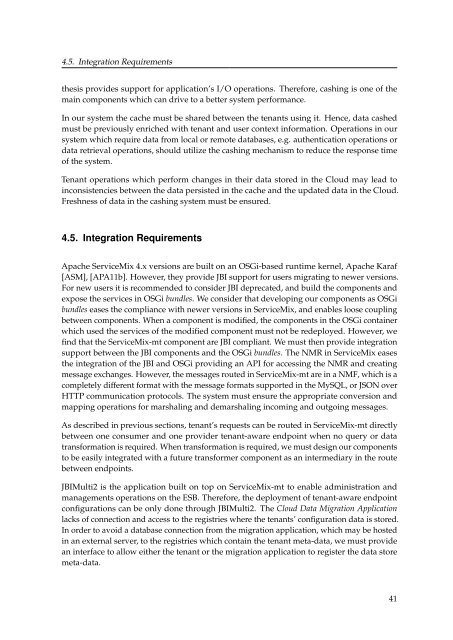Diploma Thesis Santiago Gómez Sáez - IAAS
Diploma Thesis Santiago Gómez Sáez - IAAS
Diploma Thesis Santiago Gómez Sáez - IAAS
Create successful ePaper yourself
Turn your PDF publications into a flip-book with our unique Google optimized e-Paper software.
4.5. Integration Requirements<br />
thesis provides support for application’s I/O operations. Therefore, cashing is one of the<br />
main components which can drive to a better system performance.<br />
In our system the cache must be shared between the tenants using it. Hence, data cashed<br />
must be previously enriched with tenant and user context information. Operations in our<br />
system which require data from local or remote databases, e.g. authentication operations or<br />
data retrieval operations, should utilize the cashing mechanism to reduce the response time<br />
of the system.<br />
Tenant operations which perform changes in their data stored in the Cloud may lead to<br />
inconsistencies between the data persisted in the cache and the updated data in the Cloud.<br />
Freshness of data in the cashing system must be ensured.<br />
4.5. Integration Requirements<br />
Apache ServiceMix 4.x versions are built on an OSGi-based runtime kernel, Apache Karaf<br />
[ASM], [APA11b]. However, they provide JBI support for users migrating to newer versions.<br />
For new users it is recommended to consider JBI deprecated, and build the components and<br />
expose the services in OSGi bundles. We consider that developing our components as OSGi<br />
bundles eases the compliance with newer versions in ServiceMix, and enables loose coupling<br />
between components. When a component is modified, the components in the OSGi container<br />
which used the services of the modified component must not be redeployed. However, we<br />
find that the ServiceMix-mt component are JBI compliant. We must then provide integration<br />
support between the JBI components and the OSGi bundles. The NMR in ServiceMix eases<br />
the integration of the JBI and OSGi providing an API for accessing the NMR and creating<br />
message exchanges. However, the messages routed in ServiceMix-mt are in a NMF, which is a<br />
completely different format with the message formats supported in the MySQL, or JSON over<br />
HTTP communication protocols. The system must ensure the appropriate conversion and<br />
mapping operations for marshaling and demarshaling incoming and outgoing messages.<br />
As described in previous sections, tenant’s requests can be routed in ServiceMix-mt directly<br />
between one consumer and one provider tenant-aware endpoint when no query or data<br />
transformation is required. When transformation is required, we must design our components<br />
to be easily integrated with a future transformer component as an intermediary in the route<br />
between endpoints.<br />
JBIMulti2 is the application built on top on ServiceMix-mt to enable administration and<br />
managements operations on the ESB. Therefore, the deployment of tenant-aware endpoint<br />
configurations can be only done through JBIMulti2. The Cloud Data Migration Application<br />
lacks of connection and access to the registries where the tenants’ configuration data is stored.<br />
In order to avoid a database connection from the migration application, which may be hosted<br />
in an external server, to the registries which contain the tenant meta-data, we must provide<br />
an interface to allow either the tenant or the migration application to register the data store<br />
meta-data.<br />
41

















